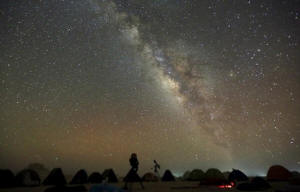|
The bright side: global 'light pollution'
obscures starry nights
 Send a link to a friend
Send a link to a friend
 [June 11, 2016]
By Will Dunham [June 11, 2016]
By Will Dunham
WASHINGTON (Reuters) - When Vincent van
Gogh peered out the window of the Saint-Paul asylum at the nighttime sky
in Saint-Rémy in 1889, he saw the brilliant light of innumerable stars
over southern France that inspired his evocative painting "The Starry
Night."
But nights no longer are so starry for billions of people. About
83 percent of the world's population, including more than 99 percent
in Europe and the United States, live in areas beset by nocturnal
"light pollution" from the incessant glow of electric lights,
researchers said on Friday.
It is so pervasive that more than a third of people globally,
including nearly 80 percent of North Americans and 60 percent of
Europeans, cannot see the luminous band of the Milky Way, a familiar
nighttime sight for the eons of human existence.
"It is surprising how in a few decades of lighting growth we have
enveloped most of humanity in a curtain of light that hides the view
of the greatest wonder of nature: the universe itself," said Fabio
Falchi of the Light Pollution Science and Technology Institute in
Italy, who led the research published in the journal Science
Advances.
 "Our civilization's roots are connected to the night sky in every
field, from literature to art to philosophy to religion and, of
course, to science."
Physicist Christopher Kyba of the GFZ German Research Centre for
Geosciences added, "Appreciating beauty is just part of what makes
us human."
The researchers used satellite and sky brightness data to create a
global atlas of light pollution, the artificial illumination of the
night sky sufficient to substantially wash out starlight. It is one
of humankind's most omnipresent forms of environmental alteration,
exemplified by the nocturnal glow over cities.
"Countries even as large as Italy or Spain or France or Germany do
not have any single spot in their territory with a pristine night
sky," Falchi added.
[to top of second column] |

The 'Milky Way' is seen in the night sky around telescopes and camps
of people over rocks in the White Desert north of the Farafra Oasis
southwest of Cairo May 16, 2015. REUTERS/Amr Abdallah Dalsh

Despite the American West's vast open spaces, almost half of U.S.
territory has light-polluted nights. The East Coast is particularly
hit hard, with only part of Maine and the islands at the end of the
Florida Keys having pristine sky quality, U.S. National Park Service
researcher Dan Duriscoe said.
The most light-polluted country is Singapore. The hardest-hit G20
countries are Italy and South Korea.
Only small areas in western Europe remain relatively unaffected,
mostly in Scotland, Sweden and Norway. Australia and Africa are
least-affected among the populated continents.
(Reporting by Will Dunham; Editing by David Gregorio)
[© 2016 Thomson Reuters. All rights
reserved.]
Copyright 2016 Reuters. All rights reserved. This material may not be published,
broadcast, rewritten or redistributed.
 |